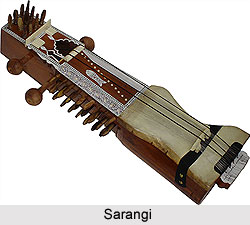 History of Sarangi dates back to the 19th century. Following the eclipse of Dhrupad and the confinement of Khayal in princely courts in the 19th century, Thumri rose in popular esteem. It also came to be associated with the culture of the Kothas and Nautch girls. The decline of the Kothas, from the late 19th century, owing to several social, cultural and historical factors, led to a rapid decline in the popularity of the instrument. However, it is also a fact that reputed Sarangi players taught classical vocal music to courtesans well into the 20th century.
History of Sarangi dates back to the 19th century. Following the eclipse of Dhrupad and the confinement of Khayal in princely courts in the 19th century, Thumri rose in popular esteem. It also came to be associated with the culture of the Kothas and Nautch girls. The decline of the Kothas, from the late 19th century, owing to several social, cultural and historical factors, led to a rapid decline in the popularity of the instrument. However, it is also a fact that reputed Sarangi players taught classical vocal music to courtesans well into the 20th century.
Throughout history, the Sarangi has been played by popular poets and minstrels of India. At some stage, the more talented and ambitious amongst them were attracted by the glamour of city life, and drifted towards the feudal courts to make a living as accompanists to courtesans. In this way the Sarangi evolved as an important instrument in art music. With the passage of time Sarangi became the preferred melodic accompaniment for many female as well as male singers.
Sarangi players were related to the complete range of music performed in the salons of the courtesans. These fulfilled the needs of refined society til the end of the nineteenth century in northern India. The instrument soon became an integral part of the vocalist`s ensemble. It found its place in various forms of music, Thumari and Ghazal, the devotional Qawwali and Khayal. Performers of the dhrupad genre, however, have kept away from any form of melodic accompaniment, preferring to sing accompanied only by the tanapilra.
By the early nineteenth century, Sarangi players had become formidable repositories of raaga knowledge and compositions, and were recognized as maestros in their own right. Their art had become a part of the system of hereditary musicianship, giving rise to several distinguished families of sarangi players. In the salons of the courtesans, sarangi players became tutors of female singers and custodians of the vocalist arts.
In the early twentieth century, Victorian morals imposed by India`s colonial rulers, and social reformist movements launched by the Indian bourgeoisie, pushed the institution of courtesans to the brink. Although art music was not their target, their impact severely dented the future of the sarangi. The final blow however came from the harmonium, invented in Paris which caught on speedily as a replacement for the Sarangi.




















